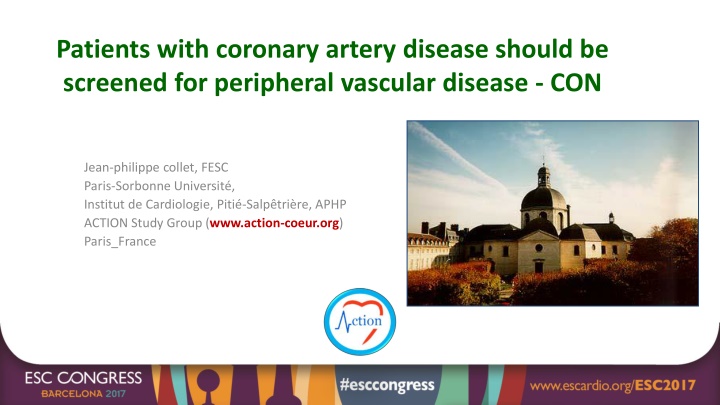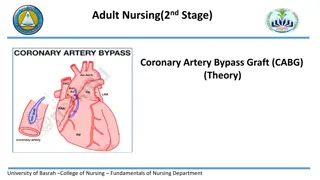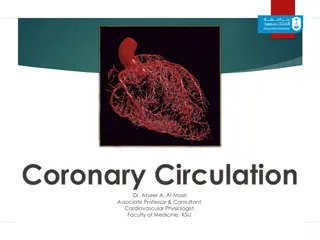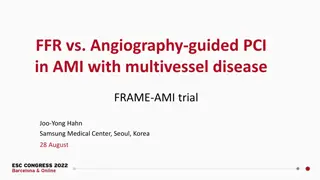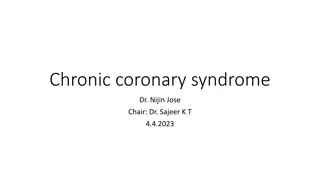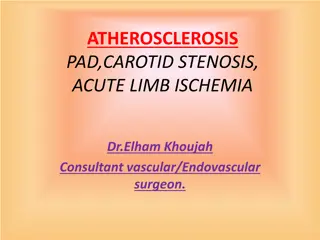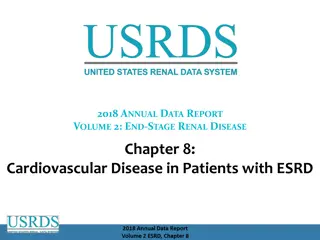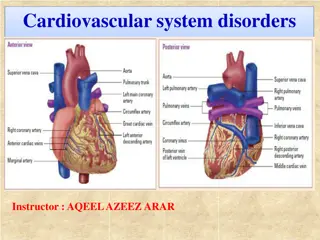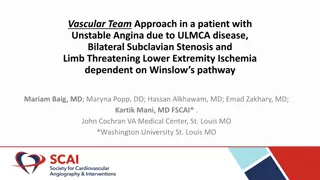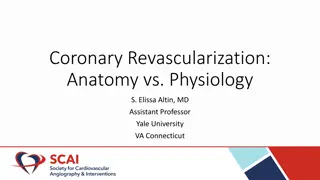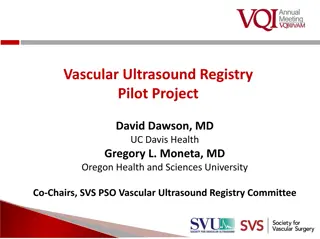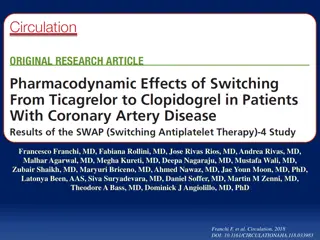Screening for Peripheral Vascular Disease in Patients with Coronary Artery Disease
Patients with coronary artery disease should be screened for peripheral vascular disease as it is a frequent integrator of global cardiovascular risk. The association of atherosclerosis in various arterial diseases highlights the importance of identifying multisite artery disease. The prevalence and impact of asymptomatic multisite artery disease in high-risk coronary patients remain unknown, warranting further evaluation.
Download Presentation

Please find below an Image/Link to download the presentation.
The content on the website is provided AS IS for your information and personal use only. It may not be sold, licensed, or shared on other websites without obtaining consent from the author.If you encounter any issues during the download, it is possible that the publisher has removed the file from their server.
You are allowed to download the files provided on this website for personal or commercial use, subject to the condition that they are used lawfully. All files are the property of their respective owners.
The content on the website is provided AS IS for your information and personal use only. It may not be sold, licensed, or shared on other websites without obtaining consent from the author.
E N D
Presentation Transcript
Patients with coronary artery disease should be screened for peripheral vascular disease - CON Jean-philippe collet, FESC Paris-Sorbonne Universit , Institut de Cardiologie, Piti -Salp tri re, APHP ACTION Study Group (www.action-coeur.org) Paris_France
Disclosures Research grants from Bristol-Myers Squibb, Sanofi-Aventis, Eli Lilly, Guerbet Medical, Medtronic, Boston Scientific, Cordis, Stago, Centocor, Fondation de France, INSERM, Federation Francaise de Cardiologie, and Soci t Fran aise de Cardiologie; Consulting fees from Sanofi-Aventis, Eli Lilly, and Bristol-Myers Squibb; and lecture fees from Bristol-Myers Squibb, Sanofi-Aventis, and Eli Lilly.
Background Steg PG. JAMA 2007;297:1197-206; Alberts MJ. Eur Heart J 2009;30:2318-26; Subherwal S. Circ CVQO 2012;5:541-9; Wilson WM. AJC 2011;108:936-42.
Background Coronary Artery Disease the most frequent and severe location of atherosclerosis Symptomatic multisite artery disease (MSAD) frequent Symptomatic multisite artery disease (MSAD) integrator of the global CV risk (2-fold increase in MACCE versus Single site) Steg PG. JAMA 2007;297:1197-206; Alberts MJ. Eur Heart J 2009;30:2318-26; Subherwal S. Circ CVQO 2012;5:541-9; Wilson WM. AJC 2011;108:936-42.
REPORTED RATE RANGES OF OTHER LOCALIZATIONS OF ATHEROSCLEROSIS IN PATIENTS WITH A SPECIFIC ARTERIAL DISEASE 72% 70% 61% Prevalence of the association CAD 60% Carotid stenosis >70% 50% LEAD (ABI <0.90) 40% 39% RAS >75% 30% 23% 22% 19% 25% 20% 16% 15% 9% 18% 10% 14% 10% 5% 7% 4% 0% CAD Carotid Stenosis >70% LEAD (ABI <0.90)
1-year outcome according to symptomatic MSAD 8 7,1 0 1 2 3 5,7 6 Percent 3,8 3,7 4 3,4 2,9 2,4 1,9 2 1,5 1,5 1,5 1,4 1,2 0,8 0,7 0,6 0 CV death Non-fatal MI Non-fatal stroke CV death / MI / stroke Steg PG. JAMA 2007;297:1197-206; Alberts MJ. Eur Heart J 2009;30:2318-26; Subherwal S. Circ CVQO 2012;5:541-9; Wilson WM. AJC 2011;108:936-42.
Background (2) The prevalence and associated-risk of asymptomatic MSAD in high risk coronary patients are unknown. Whether systematic identification of MSAD and treatment when appropriate combined with an aggressive secondary prevention is relevant has not been evaluated.
Carotid disease in patients scheduled for CABG Steg PG. JAMA 2007;297:1197-206; Alberts MJ. Eur Heart J 2009;30:2318-26; Subherwal S. Circ CVQO 2012;5:541-9; Wilson WM. AJC 2011;108:936-42.
Carotid disease in patients scheduled for CABG Carotid disease Prevalence Risk of post-CABG stroke unilateral stenosis 50-99% 11.1% 3.2% bilateral stenosis 50-99% 5.6% 5.2% unilateral occlusion 1.3% 9.0% 86-95% of post-CABG strokes are not related to carotid disease Revascularization strategies CEA synchronous with off-pump CABG has lowest 30-day death/stroke rates (2.2%) Synchronous CEA (before) + CABG is the worst strategy: 30-day death/stroke = 8.2% Staged (or same-day) CAS + CABG is an alternative: 30-day death/stroke = 5.9%
ESC PAD Guidelines 2017: screening for CAD in CABG Recommendations Class Level In patients undergoing CABG, DUS is recommended in patients with a recent (<6 months) history of TIA/stroke. I B In patients with no recent (< 6 months) history of TIA/stroke, DUS may be considered in the following cases: age 70 years, multivessel coronary artery disease, concomitant LEAD, or carotid bruit. IIb B Screening for carotid stenosis is not indicated in patients requiring urgent CABG with no recent stroke/TIA. III C Kim JC. JVS 2016;63:710-4; Aboyans V. Presse Med 2009;38:977-86.
Management of carotid stenosis in patients undergoing CABG Recommendations Class Level In neurologically asymptomatic patients scheduled for CABG: Routine prophylactic carotid revascularization in patients with a 70-99% carotid stenosis is not recommended. Carotid revascularization may be considered in patients with bilateral 70-99% carotid stenoses or 70-99% carotid stenosis + contralateral occlusion. Carotid revascularization may be considered in patients with a 70 99% carotid stenosis, in the presence of one or more characteristics that may be associated with an increased risk of ipsilateral stroke,*in order to reduce stroke risk beyond the perioperative period. III B IIb B IIb C Naylor AR. EJVEVS 2008;35:383-91. *Contralateral TIA/stroke; Ipsilateral silent infarction; Stenosis progression >20%; Spontaneous embolization on TCD; Impaired cerebral vascular reserve; Large or echolucent plaques; Increased juxta-luminal hypoechogenic area; Intraplaque haemorrhage or Lipid-rich necrotic core at MRI
LEAD in patients with SCAD Steg PG. JAMA 2007;297:1197-206; Alberts MJ. Eur Heart J 2009;30:2318-26; Subherwal S. Circ CVQO 2012;5:541-9; Wilson WM. AJC 2011;108:936-42.
ESC PAD Guidelines 2011 Patients with Lower Extremity Artery Disease associated with CAD are at twice the level of risk as those presenting with CAD alone. Whether the management of CAD patients should differ in the case of concurrent LEAD is not obvious. There are no specific trials. Eur Heart J. 2011 Nov;32(22):2851-906
Screening of concomitant LEAD and CAD PAD Guidelines 2017 Recommendations Class Level In patients with CAD, screening for LEAD by ABI measurement may be considered for risk stratification. IIb B Mukherjee D. AJC 2007;100:1 6; Subherwal S. Circ CVQO 2012;5:541-9; Collet JP, submitted; Saw J. JACC 2006;48:1567-72; Aboyans V. JACC 2005;46:815-20; Rihal CS. Circulation 1999;100:171.7; Valgimigli M. Lancet 2015;385:2465-76; Jonew WS. AMJ 2011;108:380-4; Inglis SC. IJC 2013;168:1094-101; Nakamura Y. Circ J 2015;79:785-93; van Straten AH. ATS 2010;89:414-20 www.escardio.org/guidelines 2017 ESC Guidelines on the Diagnosis and Treatment of Peripheral Arterial Diseases, in collaboration with ESVS (European Heart Journal 2017; doi:10.1093/eurheartj/ehx095) www.escardio.org/guidelines 14
LEAD to guide DAPT duration Bonaca MP JACC 2016; 67: 2719-28 DAPT Update 2017
Screening of associated atherosclerotic disease in additional vascular territories Screened disease CAD LEAD Carotid Renal Leading disease CAD Scheduled for CABG IIbc IIaa U Ib Not scheduled for CABG IIb NR U a Especially if venous harvesting is planned. bIn patients with stroke/TIA. cIn asymptomatic patients with: age 70 yrs, multivessel CAD, associated LEAD or carotid bruit. dScreening with ECG www.escardio.org/guidelines www.escardio.org/guidelines in all patients; with imaging stress testing in case of poor functional capacity and >2 of the following: history of CAD, heart failure, stroke/TIA, CKD, diabetes requiring insulin therapy. NR = no recommendation; U = uncertain. 2017 ESC Guidelines on the Diagnosis and Treatment of Peripheral Arterial Diseases, in collaboration with ESVS (European Heart Journal 2017; doi:10.1093/eurheartj/ehx095) 16
Prognosis Implications Steg PG. JAMA 2007;297:1197-206; Alberts MJ. Eur Heart J 2009;30:2318-26; Subherwal S. Circ CVQO 2012;5:541-9; Wilson WM. AJC 2011;108:936-42.
AMERICA Study: Rationale To demonstrate the superiority of a pro-active strategy of detection and management of the extension of atherothrombosis to other territories than coronary combined pharmacological secondary prevention strategy in a population with very high risk features of coronary disease (pro-active strategy) As compared with a conservative strategy based on a clinically-guided identification of MSAD and standard pharmacological treatment (conventional strategy). with an aggressive
Primary Endpoint at 2 years-FU* * death, any ischemic event leading to rehospitalization or any evidence of organ failure
Main secondary endpoint at 2 years-FU* * All-cause death, MI, stroke or any revascularization Subjects at risk: Active arm Conservative arm 258 263 236 226 223 217 208 205 147 147
Localisation of MSAD (n=56) Pro-active group (n=263) Aortic arch Carotid (extra and intracranial) Aortic Abdominal Aneurism 50mm Aortic Abdominal Aneurism <50mm Renal artery disease Visceral arteries Femoro-iliac stenosis 1 (2%) 9 (4.5%) 1 (0.5%) 11 (5.9%) 6 (3.5%) 4 (2.5%) 27 (13.8%)
Key Messages MSAD is identified in one out of five patients MSAD is associated with worse clinical outcomes; Systematic screening for asymptomatic MSAD is not indicated Clinical assessment of symptoms of MSAD is necessary; Patients scheduled for CABG or CEA represent specific subsets where identification of asymptomatic lesions may affect outcome Slides available at
